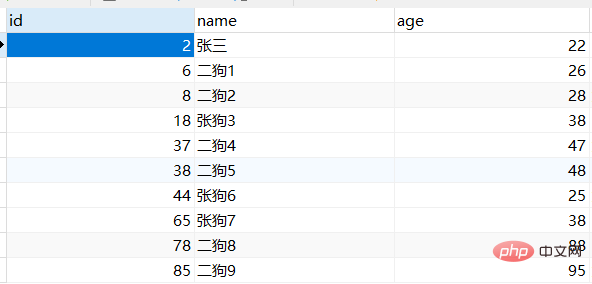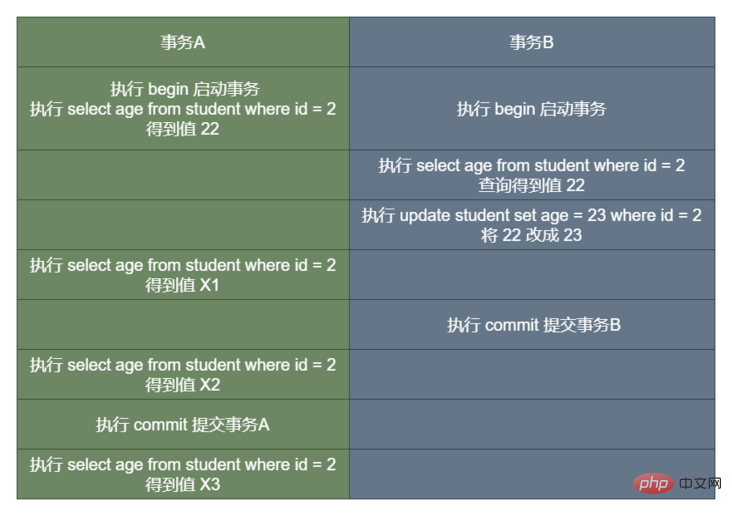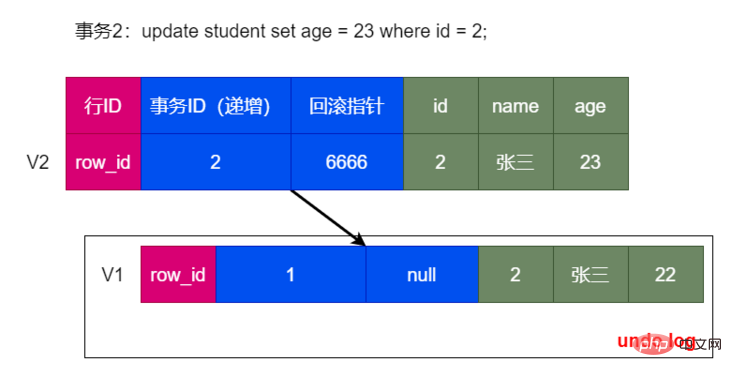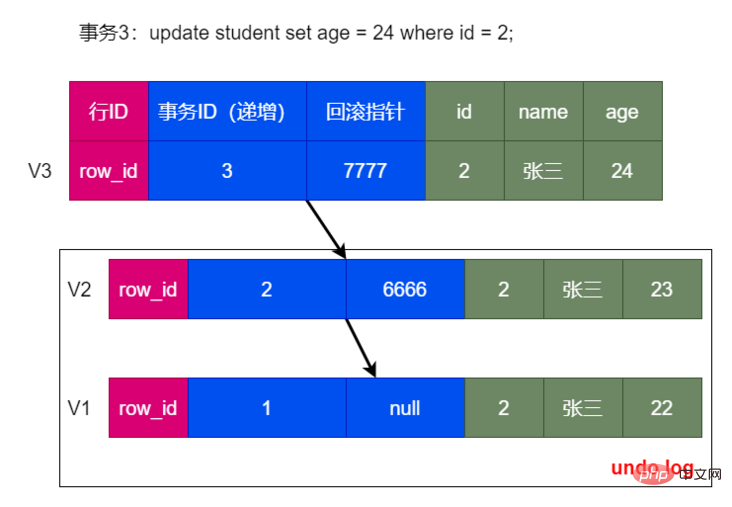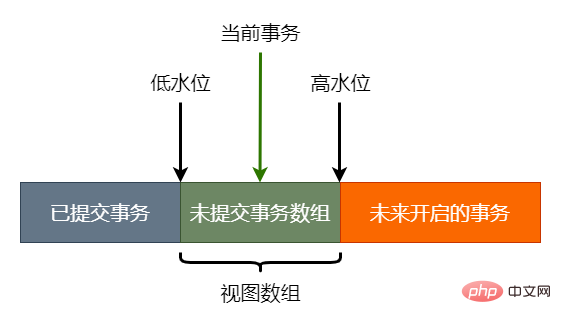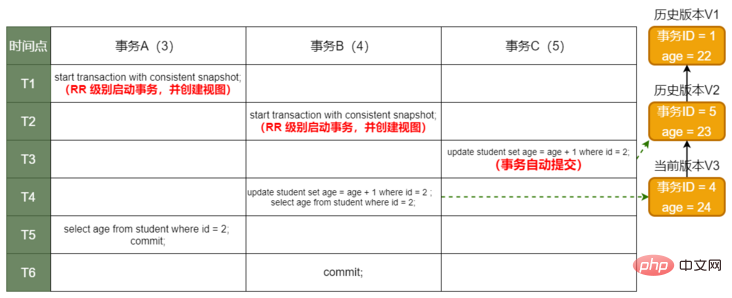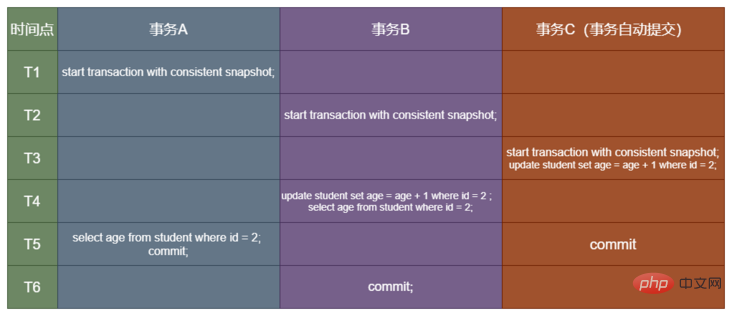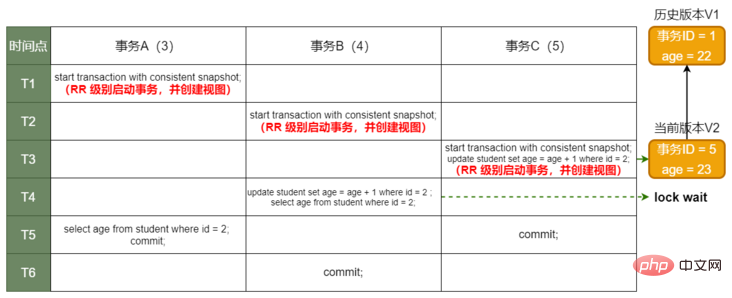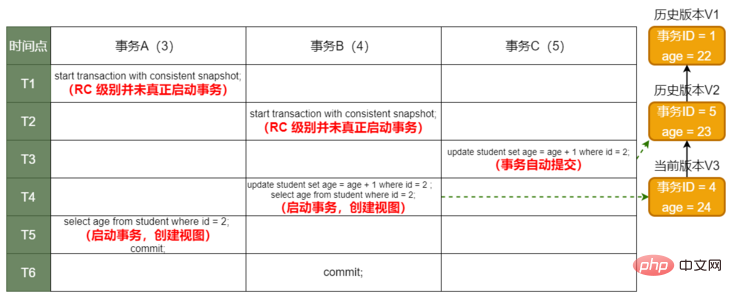 Database
Database
 Mysql Tutorial
Mysql Tutorial
 An article explaining the principles of transactions and MVCC in MySQL in detail
An article explaining the principles of transactions and MVCC in MySQL in detail
An article explaining the principles of transactions and MVCC in MySQL in detail
This article will take you to understand the transactions in MySQL and introduce the principle of MVCC. I hope it can help you!

#01 What is a transaction?
Database transaction refers to a set of data operations. The operations within the transaction are either all successful or all failed. Nothing is done. In fact, it is not that nothing is done. It is possible that some of it is done, but as long as If one step fails, all operations must be rolled back, which is a bit of a non-stop operation.
In MySQL, transaction support is implemented at the engine layer. MySQL is a system that supports multiple engines, but not all engines support transactions. For example, MySQL's native MyISAM engine does not support transactions, which is one of the important reasons why MyISAM was replaced by InnoDB.
1.1 Four major characteristics
- Atomicity: After the transaction starts, all operations are either completed or completed If you don’t do it, you won’t be stuck in the middle. If an error occurs during transaction execution, it will be rolled back to the state before the transaction started, and all operations will be as if they did not happen. That is to say, affairs are an indivisible whole, just like atoms learned in chemistry, which are the basic units of matter.
- Consistency: Before and after the transaction starts and ends, the integrity constraints of the database are not violated. For example, when A transfers money to B, it is impossible for A to deduct the money but B not to receive it.
- Isolation: Only one transaction is allowed to request the same data at the same time, and there is no interference between different transactions. For example, A is withdrawing money from a bank card. B cannot transfer money to this card before A's withdrawal process is completed.
- Durability (Durability): After the transaction is completed, all updates to the database by the transaction will be saved to the database and cannot be rolled back.
1.2 Isolation level
Among the four major characteristics of SQL transactions, atomicity, consistency, and durability are all relatively easy to understand. But the isolation level of transactions is indeed difficult. Today we will mainly talk about the isolation of MySQL transactions.
SQL standard transaction isolation from low to high levels are: read uncommitted (read uncommitted), read committed (read committed), repeatable read (repeatable read) and serializable (serializable) ). The higher the level, the lower the efficiency.
- Read uncommitted: When a transaction has not been committed, the changes it makes can be seen by other transactions.
- Read commit: After a transaction is committed, the changes it makes will be seen by other transactions.
- Repeatable read: The data seen during the execution of a transaction is always consistent with the data seen when the transaction is started. Of course, under the repeatable read isolation level, uncommitted changes are also invisible to other transactions.
- Serialization: As the name implies, for the same row of records, "write" will add a "write lock", and "read" will add a "read lock". When a read-write lock conflict occurs, the transaction accessed later must wait for the completion of the previous transaction before it can continue to execute. So all data under this isolation level is the most stable, but the performance is also the worst.
1.3 Solved concurrency issues
SQL transaction isolation level is designed to solve concurrency issues to the greatest extent:
- Dirty read: Transaction A reads the data updated by transaction B, and then B rolls back the operation, then the data read by A is dirty data
- Non-repeatable read: Transaction A has more When transaction A reads the same data multiple times, transaction B updates and submits the data, resulting in inconsistent results when transaction A reads the same data multiple times.
- Phantom reading: System administrator A changed the grades of all students in the database from specific scores to ABCDE grades, but system administrator B inserted a record of specific scores at this time. When system administrator A After the modification is completed, I find that there is still one record that has not been modified, as if I have hallucinated. This is called phantom reading.
SQL Different transaction isolation levels can solve different concurrency problems, as shown in the following table: Only the serialized isolation level solves all three problems, and the other 3 Each isolation level has flaws.
| Transaction isolation level | Dirty read | Non-repeatable read | Phantom read |
|---|---|---|---|
| Read Uncommitted | Possible | Possible | Possible |
| Read Committed | Impossible | Possible | Possible |
| Repeatable Read | Impossible | impossible | possible |
| impossible | impossible | impossible |
The above is the detailed content of An article explaining the principles of transactions and MVCC in MySQL in detail. For more information, please follow other related articles on the PHP Chinese website!

Hot AI Tools

Undresser.AI Undress
AI-powered app for creating realistic nude photos

AI Clothes Remover
Online AI tool for removing clothes from photos.

Undress AI Tool
Undress images for free

Clothoff.io
AI clothes remover

Video Face Swap
Swap faces in any video effortlessly with our completely free AI face swap tool!

Hot Article

Hot Tools

Notepad++7.3.1
Easy-to-use and free code editor

SublimeText3 Chinese version
Chinese version, very easy to use

Zend Studio 13.0.1
Powerful PHP integrated development environment

Dreamweaver CS6
Visual web development tools

SublimeText3 Mac version
God-level code editing software (SublimeText3)

Hot Topics
 1677
1677
 14
14
 1429
1429
 52
52
 1333
1333
 25
25
 1278
1278
 29
29
 1257
1257
 24
24
 Laravel Introduction Example
Apr 18, 2025 pm 12:45 PM
Laravel Introduction Example
Apr 18, 2025 pm 12:45 PM
Laravel is a PHP framework for easy building of web applications. It provides a range of powerful features including: Installation: Install the Laravel CLI globally with Composer and create applications in the project directory. Routing: Define the relationship between the URL and the handler in routes/web.php. View: Create a view in resources/views to render the application's interface. Database Integration: Provides out-of-the-box integration with databases such as MySQL and uses migration to create and modify tables. Model and Controller: The model represents the database entity and the controller processes HTTP requests.
 MySQL and phpMyAdmin: Core Features and Functions
Apr 22, 2025 am 12:12 AM
MySQL and phpMyAdmin: Core Features and Functions
Apr 22, 2025 am 12:12 AM
MySQL and phpMyAdmin are powerful database management tools. 1) MySQL is used to create databases and tables, and to execute DML and SQL queries. 2) phpMyAdmin provides an intuitive interface for database management, table structure management, data operations and user permission management.
 MySQL vs. Other Programming Languages: A Comparison
Apr 19, 2025 am 12:22 AM
MySQL vs. Other Programming Languages: A Comparison
Apr 19, 2025 am 12:22 AM
Compared with other programming languages, MySQL is mainly used to store and manage data, while other languages such as Python, Java, and C are used for logical processing and application development. MySQL is known for its high performance, scalability and cross-platform support, suitable for data management needs, while other languages have advantages in their respective fields such as data analytics, enterprise applications, and system programming.
 Laravel framework installation method
Apr 18, 2025 pm 12:54 PM
Laravel framework installation method
Apr 18, 2025 pm 12:54 PM
Article summary: This article provides detailed step-by-step instructions to guide readers on how to easily install the Laravel framework. Laravel is a powerful PHP framework that speeds up the development process of web applications. This tutorial covers the installation process from system requirements to configuring databases and setting up routing. By following these steps, readers can quickly and efficiently lay a solid foundation for their Laravel project.
 Explain the purpose of foreign keys in MySQL.
Apr 25, 2025 am 12:17 AM
Explain the purpose of foreign keys in MySQL.
Apr 25, 2025 am 12:17 AM
In MySQL, the function of foreign keys is to establish the relationship between tables and ensure the consistency and integrity of the data. Foreign keys maintain the effectiveness of data through reference integrity checks and cascading operations. Pay attention to performance optimization and avoid common errors when using them.
 Compare and contrast MySQL and MariaDB.
Apr 26, 2025 am 12:08 AM
Compare and contrast MySQL and MariaDB.
Apr 26, 2025 am 12:08 AM
The main difference between MySQL and MariaDB is performance, functionality and license: 1. MySQL is developed by Oracle, and MariaDB is its fork. 2. MariaDB may perform better in high load environments. 3.MariaDB provides more storage engines and functions. 4.MySQL adopts a dual license, and MariaDB is completely open source. The existing infrastructure, performance requirements, functional requirements and license costs should be taken into account when choosing.
 SQL vs. MySQL: Clarifying the Relationship Between the Two
Apr 24, 2025 am 12:02 AM
SQL vs. MySQL: Clarifying the Relationship Between the Two
Apr 24, 2025 am 12:02 AM
SQL is a standard language for managing relational databases, while MySQL is a database management system that uses SQL. SQL defines ways to interact with a database, including CRUD operations, while MySQL implements the SQL standard and provides additional features such as stored procedures and triggers.
 MySQL: The Database, phpMyAdmin: The Management Interface
Apr 29, 2025 am 12:44 AM
MySQL: The Database, phpMyAdmin: The Management Interface
Apr 29, 2025 am 12:44 AM
MySQL and phpMyAdmin can be effectively managed through the following steps: 1. Create and delete database: Just click in phpMyAdmin to complete. 2. Manage tables: You can create tables, modify structures, and add indexes. 3. Data operation: Supports inserting, updating, deleting data and executing SQL queries. 4. Import and export data: Supports SQL, CSV, XML and other formats. 5. Optimization and monitoring: Use the OPTIMIZETABLE command to optimize tables and use query analyzers and monitoring tools to solve performance problems.



